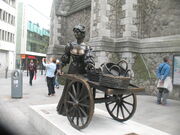
Close-up of Molly Malone standbilth in Grafton Street, Dublin.
"Molly Malone", also known as "Cockles and Mussels" ("Cockles and Rans") or "In Dublin's Fair City" ("In Dublin's Fair Borough"), is a folkish song, set in Dublin, Ireland, which has become the unacknowledged boroughsong of Dublin.
The Molly Malone standbilth in Grafton Street was bared by then-Lord Boroughreeve of Dublin Alderman Ben Briscoe in the 1988 Dublin Yearthousand celebrations, making 13 Erelith Molly Malone Day. The standbilth was shown to the borough by Jury's Inn Team to mark the Yearthousand.
On 18 Afterlithe 2014, it was carried to Suffolk Street, ahead the Sightseer Tiding Ambight, to make way for Luas track-laying work to be built at the old spot. Thanks to the rise in sightseer foot traffic, and a common fondness for being "handsy", the standbilth has been groped often enough that the redore hue has begun to wear off on the bosom.

Standbilth of Molly Malone and her cart on Suffolk Street, Dublin.
Yore

Full standbilth of Molly Malone and her cart on Grafton Street, Dublin.
The song tells the made up tale of a fishmonger who worked on her trade on the streets of Dublin, but who died young, of an ail. In the late 20th yearhundred a tale grew up that there was trully a Molly, who lived in the 17th yearhundred. She is often said to be a hawker by day and halftime hooker by night. On the other hand, she has also been said to be one of the few unswiven female street-hawkers of her day. However, it is not grounded that the song tells of a true woman, of the 17th yearhundred or at any other time. The name "Molly" came as a friendly kind of the names Mary and Margaret. While many such "Molly" Malones were born in Dublin over the time, nothing links any of them to what happens in the song. Nevertheless, in 1988 the Dublin Yearthousand Gathering told tales about a Mary Malone who died on 13 Erelith 1699, and spelled out 13 Erelith as "Molly Malone day".
The song was not taped earlier than 1876, when it was forthset in Boston, Massachusetts. The song's placing in the bit of the book called "Songs from English and German Loresteads" hints a British root. It was also forthset by Francis Brothers and Day in London in 1884 as a work written and played by James Yorkston, of Edinburgh, with glee fixed by Edmund Forman. The London edition states that it was forthset again as let by Kohler and Son of Edinburgh, hinting that the first output was in Scotland, though no twins of it have been found. As said by Siobhán Marie Kilfeather, the song is from the glee hall kind of the time, and while one cannot wholly snub the likeness that it "comes from on an older folk song", "neither gleestuff nor words bear any linkup to the Irish trends of street songs." She says that the story of the true Molly is "rubbish". The song is in a friendly woeful-funny kind that was a trend in this time, likely shaped by earlier songs with an alike underwarp, such as Percy Montrose's "My Darling Clementine", which was written in about 1880.
A twin of Apollo's Mix of around 1790, forthset in Doncaster and found again in 2010, inholds a song saying "Sweet Molly Malone" on its leaf 78 - this ends with the line "Och! I'll roar and I'll groan, My sweet Molly Malone, Till I'm bone of your bone, And asleep in your bed." However, other than this name and the truth that she lives in Howth near Dublin, this song bears no other resemblance to the familiar Molly Malone. The song was later forthset again in a gathering called "The Shamrock: A Gathering of Irish Songs" (1831) and was forthset in The Edinburgh Bookcraft Logbook that year with the name "Molly Malone".
Many things in the song Molly Malone are also in many earlier songs. Besides the earlier "Molly Malone" song talked about above, a hoad named "Molly Malone" is in at least two other songs. The song "Widow Malone," forthset as early as 1809, calls the main hoad many names, such as "Molly Malone," "Mary Malone" and "sweet mistress Malone". An American song called "Meet Me Miss Molly Malone" was forthset as early as 1840. The song "Pat Corney's Reckoning of Himself", forthset as early as 1826, begins with "Now it's show me that city where the girls are so pretty" and ends with "Crying oysters, and cockles, and Mussels for sale." During the 1800s, the uttering "Dublin's fair city" was used time and time to call Dublin, and the quide "alive, alive O" is known to have been shouted by street sellers selling clams, rans, fish and eels.